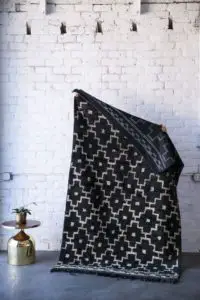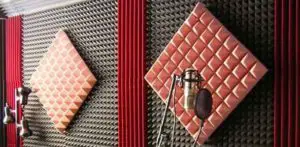Hanging carpets on your wall & the science of soundproofing!
Is the noise coming in from outside or from next door!? You probably need to do some soundproofing to keep the ambiance clear in your home or office. Carpets could do the trick.
But let’s start by clearing up the difference between soundproofing and sound-absorbing.
Soundproof vs. sound absorption
Soundproofing means you block the sound from traveling to the other side of a wall or a room. To do this, you need to use hard materials that leave no pathway for the sound.
Sound absorption can only reduce the noise level by trapping some of the sound waves inside the material. Doing this is easier than soundproofing.
Are wall carpets a good idea to reduce noise?
Yes and no. I know this is not the answer you’re looking for, but bear with me, we’ll look when it’s a good idea to use carpets.
Carpets can absorb some of the noise depending on:
- the fabric they are made of
- the thickness of the carpet
- the distance from the wall
- number of layers

Also, this will work best for high to mid frequencies of sound. Low frequencies, bass-like sounds, will still be able to get through.
Yet, in the long run, carpeting your wall can bring more disadvantages to the table.
If you decide to go for the carpet solution, take into account the way sound travels to optimize your efforts.
What happens when sound meets a wall?
Sound is carried from one side to another by air molecules. The vibration of the sound source makes the molecules bounce back and forth in a particular way. But, when they hit a hard surface, they can no longer move. This is when materials such as carpets absorb the energy of the molecules.
To do the job, place the material at an optimal distance from the wall. For a 1 kHz frequency, place the carpet at ~85mm from the wall.
Placing the carpet directly on the wall will roughly absorb only the highest frequencies. The rest will remain free to wander. You will simply own an adorned wall with the same level of noise.
What types of carpet materials work best?
Material density will make a difference in sound dampening. Choosing an efficient fabric or type of rug for your wall is important.
A material’s power to absorb sound varies with frequency. The Noise Reduction Coefficient (NRC) is a grade given to a material to show how well it works with controlling the sound in a room. A highly absorbent carpet can have an NRC of 30, while a poorly absorbent one can have an NRC of 5.

Persian carpet– This is by far the best acoustic carpet. The drawback of this one is the price. Persian carpets are usually expensive.
Orange shag– Back in the 70s, many acoustic studios were using wall treatments to take in the sound. This type of carpet turned out to be a favorite. Tested to see how efficient it is, the shag showed a very good absorption of the high frequencies range.
Woven wool– It is a material denser than cotton and with better sound-absorbing qualities. Also, wool is friends with the environment if you want to check this box as well.
Felt underlayment– The back of a carpet can weigh heavy. A felt pad can do a good job of trapping some of the noise.
Avoid carpets with rubber back seal. The sound will continue to bounce around instead of being absorbed into the fibers.
Tip: Use thick carpets. The thicker the fabric and felt pad, the better the results!
The cons of using carpet on walls
Aside from aiding you in reducing the noise, you get some nasty after-effects too. Carpets are a package deal
Maintenance– Imagine that you are not only cleaning your usual floor carpeting but also your walls now. It costs time, money, and compromises the air in your room.

Odors & stains– In time, carpets definitely will get dirty and ragged. Some stains will forever live in the fabric. Rugs may absorb sound to some degree, but they also absorb smells, and more efficiently than sound even! The smell in your room won’t be pleasant.
Allergens & moisture– The quality of the air in your house will influence the state of the items inside. Carpets are highly retentive and once moist, they never go back to 100% dry and fresh. If you suffer from allergies, carpets are not a good idea. The thicker the rug, the greater the allergic potential.
Dust & bugs– The breeding ground for dust mites and other insects is called a rug. If you don’t clean and vacuum the carpets regularly, you will be able to call yourself a bug collector.

Mildew– Moisture inside the room and in the carpet leads to mildew formation. This is not a maybe but an inevitable consequence. Mold is very bad for your health and can cause severe breathing problems.
Unaesthetic– Unless you still live in the 70s, carpets on walls are plain ugly. Every person has their own taste on the aesthetic front, but, let’s be reasonable, carpets do not look good.
Fire hazard– Check for regulations in your country and see if it is legal even to use carpets on walls. They can pose an extreme danger if a fire were to start. Carpets light up fast and spread the fire all around.
Carpets vs. foam vs. fiberglass acoustic panels
We’ve covered the carpet topic so far, and we know that carpets are not great for keeping sound at bay. Plus, they are not a professional solution.
Alternative materials are available on the market. The most common ones are foam and acoustic panels.
Foam panels

The material, also called “acoustic foam”, is polyurethane-based such as polyether or polyester. What defines these materials are the open cells that form on the surface and the inside. The role of the open cells is to trap the sound and strip it of energy until it comes out much weaker.
To block the sound, a surface needs to be dense and thick. It is not the case with foam which is very light and porous.
Foam works for high and mid-range frequencies (500Hz) but not at all for low ones. What it will do is absorb some of the sounds and slightly reduce the noise. But that’s about it!
The good news is that foam panels can make for efficient thermal insulation.
Fiberglass acoustic panels

Unlike foam panels, these use fiberglass as their main material.
The advantage is that they have a broader absorption range for frequencies. A 2-inch panel can absorb as low as 250Hz, while 4-inch panels can go down to 100Hz. Bottom line, a fiberglass panel will do a better job of reducing noise pollution.
What is more, to cover a wall with foam panels, you need twice the amount of material compared to acoustic panels. By using fiberglass acoustic panels, you don’t need to fill in the wall space to get the same result.
From an aesthetic standpoint, the acoustic panels go well in any environment, from office space to private homes. Foam is best for technical spaces like control rooms or practice areas.
Cheap DIY ways to soundproof a wall
If you’re looking for alternative ways to keep the noise coming through a certain wall, here are some ideas:
Blankets
Choose the thickest and most dense blankets at hand and hang them on your wall. Not the most pleasant-looking solution, we know. But in urgent situations when you want peace and quiet, go for it.
Heavy moving blankets used to cover belongings when transferred are very efficient. Make sure to cover the entire wall and add layers according to your needs.
Egg cartons
A popular and traditional solution, egg cartons don’t keep the sound out. However, they do reduce the echo in a room. If placed tactically in sensitive places, you can take out some of the echo and reverberation.
Please note though, egg cartons spread around your home can be a huge fire hazard!
Drywall
Not the cheapest way, but drywall can help quite a lot. Measure the wall and get the right drywall dimensions. Next, you might need a hand to handle the panels and install them. This can double your thin wall and reduce the noise coming from the other side.
Before placing it on the wall, make sure to fill in all gaps and open spaces that could let the sound through.
Foam mats
Easy to install and handle, foam mats are insulators that contain rubber foam. They are light and resistant and come equipped with adhesive on the back. All you have to do is stick them on your wall.
These are a few tricks to easily reduce the noise coming through an existing wall. Yet, they are not well-thought, long-term solutions.
If you decide to get a professional, more efficient soundproofing solution, here are some good materials and products:
- Vinyl sound barrier– blocks all sounds with its mass-loaded vinyl barrier. It is perfect for homes, studios, offices, classrooms, medical spaces, and so on.
- Resilient sound channels– used for decoupling and made from a bent, solid metal. You can attach it to your wall or ceiling making way for the air to travel.
- Soundproof curtains– 100% duck cotton canvas produced in the US. They can reduce incoming sound by up to 90%. Not only do they absorb the sound, but they also divert it.
- Green Glue Compound– efficient and affordable, the compound is easy to apply and can be used on walls, floors, or ceilings. It reduces sound transfer, and you can add as many layers as you want. It can be painted over and cleaned with soap and water.
- Acoustic sealant– used to fill in any gap in the wall or drywall that lets sound travel. It is affordable, easy to use, and makes a big difference.
- AFB (Acoustic Fire Batts) mineral wool–designed for interiors in particular. It is lightweight, made from natural stone and slag. It doesn’t ignite and has great dampening qualities. The density will definitely keep the sound out.
Wrap up
Learning about soundproofing is no piece of cake. There is a lot of information out there and twice as much material solutions, but to find what fits best for you is worth exploring a while. Cheap solutions are always available but think about this in terms of durability, efficiency, health, and safety.
Have you found your perfect match!?
